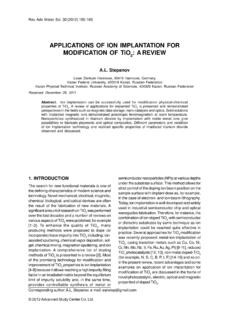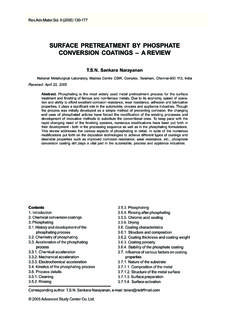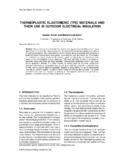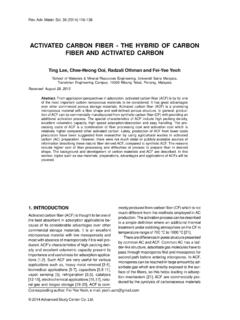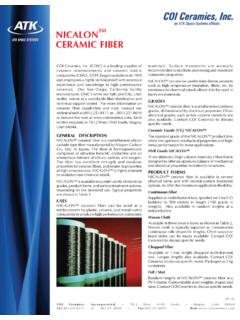Transcription of SYNTHESIS, STRUCTURE AND PROPERTIES OF …
1 1 synthesis , STRUCTURE and PROPERTIES of nanosized silicon carbide 2009 Advanced Study Center Co. 22(2009) 1-20 Corresponding author: Andrievski, e-mail: STRUCTURE AND PROPERTIES OFNANOSIZED silicon AndrievskiInstitute of Problems of Chemical Physics, Russian Academy of Sciences, Semenov prospect, 1, Chernogolovka,Moscow Region 142432, RussiaReceived: November 05, 2009 Abstract. Features of synthesis of particles, wires, tubes, films and bulk materials based on sili-con carbide in nanocrystalline/amorphous condition are considered. The main attention is taken tothe preparation of nanotubes/nanowires, films and nanosized SiC inclusions in matrixes. Theirstructure, physical, chemical and mechanical PROPERTIES are discussed in connection with the influ-ence of size effects and other features in detail. Such new results, as the hardness essentialincrease, display of the nanowire high plasticity, substantial in crease of photoluminescence spec-tra intensity, biocompatibility, good resistance to amorphization under irradiation and so on, aredescribed.
2 Applications in electronics, optics, nanotechnics and medicine are pointed. Some un-resolved problems are INTRODUCTIONT hanks to a wide spectrum of physical, chemicaland mechanical PROPERTIES and according to ex-tensive application, the mono - and polycrystalmaterials based on silicon carbide draw for a longtime a great attention (see, for example, only thelast proceedings [1-3] reflecting works of the larg-est International conferences in 2006-2008). Somedata about nanocrystalline SiC (as of 2005) havebeen reflected in the present author reviews [4,5]devoted to all range of high-melting point com-pounds. However, the number of publications onthis topic as well as the general information streamin the nanotechnology area [6] more and more ex-tends. According to SCOPUS base, in 2008 about150 articles has been devoted to nanocrystallineand amorphous objects on the SiC base. In addi-tion to indicators known earlier such as highstrength, corrosion stability and perspective semi-conductor PROPERTIES , the interesting biological,sensor and optical characteristics of silicon car-bide are revealed.
3 It has generated a need for theanalysis of last tendencies in researches and de-velopments devoted to nanomaterials-based to data [4,5], the attention will be concen-trated and on amorphous nanosubjects as for sili-con carbide considerable propensity toamorphization is it is known, silicon carbide crystallizes inmany polytypes of so-called polymorphs in onemeasurement (their total amount is more than 200[7]). For convenience of the further statement andcomparison with nanosubjects, some characteris-tics of the most widespread polytypes are shownin Table 1 [7-9] and positions in the carbon andsilicon atoms arrangement and structures are dem-onstrated in Fig. 1. The SiC polytype content isdefined by conditions of preparation (temperature,pressure and environment) and presence of impu-rities. It is considered that cubic polytype 3C-SiC ismore stable in comparison with other hexagonalpolytypes up to temperature of ~2100 C [8]. Andrievski Property POLYTYPE 3C-SiC 2H-SiC 4H-SiC6H-SiC ( SiC) ( SiC) ( SiC) ( SiC) Space group F43m P63mc P63mc P63mc Hexagonality (%) 0 10050 33 Stacking order (See Fig.)
4 1) ABC AB ABCB ABCACB Lattice constant a (nm) Lattice constant c (nm) Density (g/cm3) Band gap (eV) Thermal conductivity (W cm-1 K-1) Electron mobility 1000 850 450 (cm2 V-1s-1, 300K)Hole mobility 40 120 100 (cm2 V-1s-1, 300K) Electrical resistivity ( cm) 102 103 Table 1. The main physical/chemical PROPERTIES of the most widespread SiC polytypes [7-9].2. FEATURES OF Nanopowders, nanoparticles inmatrices, nanoporous structures,nanowires and nanotubesNanosized silicon carbide powders are manufac-tured for a long time already by several compa-nies. For example, PlasmaChem GmbH (Ger-many) delivers the SiC nanopowder with the aver-age size of particles 20 7 nm and purity> 95% (freesilicon < ; oxygen < ; chlorine < ).
5 Among new works on the SiC nanopowder syn-thesis it seems to be interesting to mark out thefollowing most interesting investigations:- synthesis of amorphous SiC nanoparticles usingthe low pressure microwave plasma [10],- controlled synthesis of -SiC nanopowders usinginductively coupled plasma [11],- synthesis -SiC nanocrystals by carbothermicreduction [12].The as-prepared amorphous SiC particles weresynthesized from the decomposition oftetramethylsilane precursor in a plasma operatedat room temperature and low precursor partial pres-sure ( Torr) using argon as carrier gas(3 Torr) [10]. The synthesis conditions were variedto prepare nanoparticles in the size 4-6 nm withreasonable monodispersity confirmed by transmis-sion electron microscopy (TEM) high organic content and excess carbon pre-sented in the as-synthesized powder particles werefixed by X-ray photoelectron spectroscopy (XPS)and Fourier-Transformed Infrared (FTIR) spectros-copy. Additional annealing the samples in argon at800 C for 30 min results in transformation of theamorphous SiC to crystalline -SiC and studies for commercial scale production ofSiC nanoparticles smaller than 10 nm are proposition in obtaining large amount ofSiC nanopowder consist in introducing coarse SiCpowders (with an average size about 1-3 m) in-side the dense plasma formed by the inductivelycoupled plasma torch [11].
6 The evaporation/con-densation process study results in preparation of -SiC cubic phase nanoparticles with variable sto-ichiometry and mean size of around 30 nm. Fur-ther investigations are now in progress in order toobtain a pure -SiC and to control the particle sizetogether with size synthesis of spherical amorphousSiO2 nanoparticles (size of 2-10 nm) with sucroseat 1500 C (with additional annealing at 700 C fordecarburization) results in preparation of powderswith typical size of 5-10 nm [12]. The X-ray diffrac-tion (XRD) study revealed the availability 6H- and3 synthesis , STRUCTURE and PROPERTIES of nanosized silicon carbideFig. 1. Positions of carbon (l) and silicon (O) atoms in the (112-0) plane for various SiC polytypes [7].Reprinted with permission from Lebedev // Semicond. Sci. Technol. 21 (2006) R 17, (c) 2006 IOPP ublishing 2. PL spectra of 6H-SiC wafer (1); nanoporous SiC layer (2), prepared by anodizing of a wafer; andSiC nanopowder (3), made by a strong mechanical grinding of the nanoporous free layer [15].
7 PL mea-surements (T = 9K) were performed using a laser line at eV from a frequency doubled Ar+ laser forthe exitation was measured. EGx is the band gap for 6H-SiC. Reprinted with permission from J J. Botsoa, Bluet, V. Lysenko, O. Marty, D. Barbier and G. Guillot // J. Appl. Phys. 102 (2007) 083526; (c) 2007 American Institute of Andrievski4H-SiC polytypes with high density of stacking faultsand small amount of 2H and 3C phases. The sizeeffects have been observed in photoluminescence(PL) , these results and other similar thoseare only continuations and/or some specificationsof investigations (carbothermal synthesis , plasmachemistry, laser synthesis , etc.) realized earlier andreflected in reviews [4,5]. Now the primary atten-tion of researchers is focused on preparation ofnanosized SiC inclusions in matrixes and ofnanowires/nanotubes as perspective materials foropto - and nanoelectronics (light emitting diodes,sensors, etc.) as soon as also porous ceramics forhigh-temperature filters and catalytic supports.
8 Thefollowing basic technological methods are consid-ered: electrochemical and chemical etching, car-burization of silicon and silica, implantation of car-bon ions in silicon and joint implantation of ions ofcarbon and silicon in SiO2 matrixes. These meth-ods as applied to nanosized silicon (as a materialfor nanoelectronics) were presented in book [13].The nanosized SiC synthesis methods as appliedto electrical/optical PROPERTIES were discussed byresults up to 2005 in review [14] with a compre-hensive description of technological analogy with nanosized silicon [13], the PLSiC spectra increase in nanoporous conditions isalso observed. Fig. 2 shows low temperature PLspectra for 6H-SiC substrate, nanoporous SiC layerand SiC nanoparticles by the size less than 10 nm[15].From these data the considerable PL increasefor two last subjects and especially for isolatednanoparticles is clearly evident. This phenomenonis connected with the quantum confinement is considered also that the appreciable contribu-tion in the PL increase is brought by defect struc-ture on the nanopore surface that is formed at etch-ing [14].
9 Electrochemical anode etching is carried out ata current density of 210 mA/cm2 in solutionHF:C2H5OH (1:1) during 25 min [15]. For the de-tachment of a porous layer (a thickness near by100 m) from a substrate the current density quicklyincreases to 1 A/cm2. It is also reported about thepossibility of refinement of usual 3C-SiC powder(the particle size of some micrometers) tonanoparticles by the size a little nanometer bychemical etching in mix HNO3:HF (1:3) at 100 Cwithin an hour with the subsequent centrifugation,washing and so on [16].Fig. 3 displays the TEM image of SiC (includinghigh resolution TEM (HRTEM) image of onenanocrystal) and the histogram of their distributionin the sizes [16]. Apparently, synthesizednanoparticles are nearly spherical with a diameterranging from to nm (the average size nm.), and the picture of the high resolutiontestifies about high crystalinity with the lattice fringescorresponding to the {111} plane of cubic polytype3C-SiC.
10 A little agglomeration of the nanoparticleshas been also preparation of porous SiC samples the pro-cesses of carbide synthesis and formations of aporous skeleton are usually combined, that allowsto considerably lower temperature of realization andto organize nanoporous STRUCTURE . So, heating ofthe silicon powder mixes with fullerens or with sootin Na steams (promoting mass transfer) at tem-perature ~700 C allows to synthesize -SiC withporosity about 70%. The pore size distribution wasin the range of 2-10 nm and grain size was in thenanometer interval also [17]. Nanoporous siliconcarbide materials can be also prepared by thepolycarbosilane pyrolysis with and without the ad-dition of an inert filler (nano- and microsized SiCpowders) [18]. Porous materials-based SiCnanowires (diameter of ~100 nm) with honeycombstructure are reported to prepare by carbothermalreduction of silica [19].The carbidization study of porous silicon , pre-pared by electrochemical etching, has revealed the3C-SiC nanocrystals formation with the size of 5-7nm at temperature 1200-1300 C [20].
